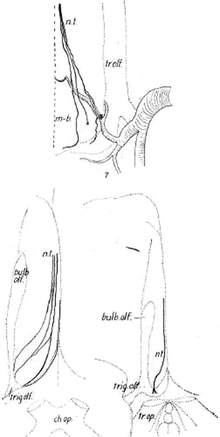Terminal nerve
The paired terminal nerve or terminal nerve ( lat. Terminalis 'belonging to the end'), also called the zeroth cranial nerve ( 0 or N ), is a 13th pair of cranial nerves in vertebrates at the base of the endbrain .

discovery
The delicate structures of the terminal nerve near the meninges have long been overlooked or removed together with the spider web skin in anatomical sections . In 1878 the anatomist Gustav Fritsch discovered the nerve on the brain of a dog shark (see illustration). In 1894 Felix Pinkus described it in a lungfish and saw its origin at the lower end of the lamina terminalis . In the frog, Pinkus' nerve - also known as the terminal nerve from 1905 - was then described in 1909, in humans only in 1913.
course
The thin nerve runs like the laterally located olfactory nerve at the base of the endbrain . In contrast to this, it consists of variable neuron populations (the ganglion cells of a ganglion terminal ), from which on the one hand peripheral processes to the olfactory epithelium and on the other hand central to the brain.
The peripheral lines from the nasal mucous membrane in the area of the nasal septum reach the cranial cavity as fila terminalia through the foramen olfactoterminale of the anterior ethmoid plate ( lamina cribrosa ) - located in front of the openings of the fila olfactoria of the olfactory nerve. The central lines reach the brain in the basal area around the trigonum olfactorium and medial olfactory regions of the endbrain and near the lamina terminalis. Core areas in the diencephalon , which are assigned a role in sexual behavior , are reached via central projections .
These fibers of Terminalissystems are thus not like the olfactory nerves via the olfactory bulb of the olfactory perception assigned. In addition to additional (accessory) projections to secondary olfactory areas , they especially form connections to core areas near the septum and in the area praeoptica .
In humans, the fiber or neuron system of the terminal nerve developed in the fetal period is later reduced. In the adult it is usually to be found bilaterally as a fine network of medullary peripheral nerve fascicles in the subarachnoid space above the rectus gyrus of the frontal lobe .
Functional assignment
The functions of the terminal nerve are still incompletely understood and during embryonic and fetal development may be different from those in the adult brain.
Some of the terminal neurons form the oligopeptide gonadoliberin (GnRH or LH-RH) and secrete it as a messenger substance, be it as a neurotransmitter or neuromodulator or as a neurohormone . Some of their neurites also reach the retina in fish and frogs , but only in the early stages of development in mammals. The pulsatile release of GnRH in diencephalic regions is discussed as a prerequisite for the development of the endocrine hypothalamic-pituitary-gonadal control circuits. In humans, a lack of the terminal nerve or a lack of immigration of terminal neurons or outgrowth of their neurites into the forebrain leads to the clinical picture of an olfacto-genital or Kallmann syndrome .
An important function of the terminal nerve, which has been proven not only in carp-like fish , is the signal transmission that mediates the effects of pheromones . In addition, for example, also in rodents, environment-oriented adaptations and influences on social behavior affecting territorial delimitation, reproductive strategies and willingness to mate.
In some cases, for example in the organum vasculosum of the lamina terminalis, nerve endings of the nervus terminalis come into close contact with blood vessels . In most cases it is not yet clear whether they may have an influence on blood flow regulation , whether they perform sensory tasks with regard to blood composition or whether they emit neuroendocrine signaling substances.
The peripheral features of the terminal nerve in the mucous membrane of the nasal cavity show considerable variability even within one species. In addition to the afferent fibers from the olfactory epithelium of the nasal septum or the Jacobson's organ ( organum vomeronasale ), visceroefferent fibers for vascular muscles and epithelial glands can also be found.
See also
Individual evidence
- ↑ According to the current Terminologia Anatomica (TA) referred to as the terminal nerve [0] , see p. 133 (or A.14.2.01.002 ).
- ↑ Felix Pinkus: The cranial nerves of Protopterus annectens. In: Gustav Schwalbe (Ed.): Morphological work. G. Fischer, Jena 1895, p. 279, here online .
- ^ C. Judson Herrick: The nervus terminalis (nerve of pinkus) in the frog. Editorial Office, Denison University, Chicago 1909, online here .
- ↑ JB Johnston: Terminal nerve in reptiles and mammals. In: Journal of Comparative Neurology. Volume 23, No. 2, April 1913, pp. 97-120, online here .
- ↑ J. Dudel, R. Menzel, R. Schmidt (Ed.): Neuroscience: From Molecule to Cognition. 2nd Edition. Springer-Verlag, 2013, ISBN 978-3-642-56497-0 , pp. 19f, online here .
- ↑ R. Northcutt, R. Puzdrowski: Projections of the olfactory bulb and nerve terminalis in the silver lamprey. In: Brain, Behavoiur and Evolution. Volume 32, No. 2, 1988, pp. 96-107; PMID 3179698 .
- ↑ G. Fuller, P. Burger: Terminal nerve (cranial nerve zero) in the adult human. In: Clinical Neuropathology. Volume 9, No. 6, 1990, pp. 279-283; PMID 2286018 .
- ↑ T. Kawai, Y. Oka, H. Eisthen: The role of the terminal nerve and GnRH in olfactory system neuromodulation. In: Zoological Science. Volume 26, No. 10, October 2009, pp. 669-680, doi : 10.2108 / zsj.26.669 , PMID 19832678 (review).
- ↑ H. Jastrow: The terminal nerve of mammals and humans. Mainz University, teaching material . here online ( Memento of the original from July 12, 2011 in the Internet Archive ) Info: The archive link has been inserted automatically and has not yet been checked. Please check the original and archive link according to the instructions and then remove this notice.

